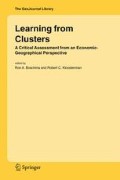Access this chapter
Tax calculation will be finalised at checkout
Purchases are for personal use only
Preview
Unable to display preview. Download preview PDF.
References
Architectenwerk http://www.architectenwerk.nl/top40/2002/totaal.htm (accessed December 23, 2003)
Architecture Week, 2000, ‘Koolhaas wins Pritzker Prize', http: //www.architectureweek.com/2000/0607/news_4-1.html (accessed June 12, 2003).
BauNetz (2004), http://www.BauNetz.de/arch/ranking/ (accessed January 16, 2004 and April 5, 2004)
Bathelt, H. and J. S. Boggs (2003), ‘Toward a reconceptualization of regional development paths: Is Leipzig's media cluster a continuation of or a rupture with the past? Economic Geography, 79(3): 265–293.
Bathelt, H., A. Malmberg and P. Maskell (2004), ‘Clusters and knowledge: local buzz, global pipelines and the process of knowledge creation', Progress in Human Geography 28(1): 31–56.
Boschma R. and J. Lambooy (1999), ‘Evolutionary economics and economic geography', Journal of Evolutionary Economics, 9(4): 411–429.
Capello, R. (2001), Milan; dynamic urbanisation economisation vs. milieu economies. In J. Simmie, ed., Innovative Cities. London/New York: Spon Press, pp. 97–128.
Colenbrander, B. (1995), Referentie OMA: de sublieme start van een architectengeneratie. Rotterdam: NAI Uitgevers/Stichting.
den Hertog P, L. Broersma and B. van Ark (2003), ‘On the soft side of innovation: Services innovation and its policy implications', The Economist-Netherlands, 151(4): 433–452.
Drucker, P. (1993), Innovation and Entrepreneurship, Harper Business, New York
Florida, R. (2002), The Rise of the Creative Class; and How It's Transforming Work, Leisure, Community and Everyday Life. New York: Basic Books
Glasmeier, A. K. (2000), Manufacturing Time; Global Competition in the Watch Industry, 1795–2000. London: The Guildford Press
Grabher, G. (2001), ‘Ecologies of creativity: the village, the Group, and the heterarchic organisation of the British advertising industry', Environment and Planning A, 33(2): 351–374.
Halbertsma, M. and P. van Ulzen (2001), ‘Op het hoekje van de Zwanensteeg'. In M. Halbertsma, M. and P. van Ulzen (red.), Interbellum Rotterdam: Kunst en cultuur 1918–1940. Rotterdam: NAI Uitgevers/Stichting Kunstpublicaties Rotterdam: 11–19.
Ibelings, H. (1995), Nederlandse architectuur van de 20ste eeuw. Rotterdam: NAi Uitgevers.
Kloosterman, R. C. (2004) ‘Recent employment trends in the cultural industries in Amsterdam, Rotterdam, The Hague and Utrecht; a first exploration', Tijdschrift voor Economische en Sociale Geografie, 95:2: 243–252.
Koolhaas, R. and B. Mau (1995), Small, Medium, Large, Extra-Large: Office for Metropolitan Architecture. Rotterdam: 010 Publishers.
Lauwen, T. (2003), Dutch Design van de 20ste eeuw. Bussum: Thot.
Lampugnani, V. M. (1989), The Thames and Hudson Encyclopedia of 20th Century Architecture. Londen: Thames and Hudson
Le Galés, P. (2002), European Cities; Social Conflicts and Governance. Oxford University Press, Oxford.
Lootsma, B (2000) Superdutch, de Tweede Moderniteit van de Nederlandse Architectuur. Nijmegen: Sun.
Mahoney, J. (2000), ‘Path dependence in historical sociology', Theory and Society, 29, pp. 507–548.
Phelps, N. & T. Ozawa (2003), ‘Contrasts in agglomeration: proto-industrial, industrial and post-industrial forms compared', Progress in Human Geography, 27(5): 583–604.
Pierson, P. (2000), ‘Increasing returns, path dependency, and the study of politics', American Political Science Review, 94:2: 251–267.
Porter, M. (2001), ‘Regions and the new economics of competition', in: A. Scott (ed.), Global City-Regions; Trends, Theory, Policy, Oxford: Oxford University Press: 139–157.
Pratt, A. C. (1997), ‘The cultural industries production system: a case study of employment change in Britain, 1984–91', Environment and Planning A, 29: 1953–74.
Rantisi, N. M. (2004), ‘The ascendancy of New York Fashion', International Journal of Urban and Regional Research, 28(1): 86–106.
Rykwert, J. (2002), The Seduction of Place; The History and Future of the City. New York: Vintage Books.
Scott, A. J. (2000), The Cultural Economy of Cities; Essays on the Geography of Image-Producing Industries. London/Thousand Oaks/New Delhi: Sage.
Scott, A. (2004), ‘Cultural-products industries and urban economic development; prospects for growth and market contestation in global context', Urban Affairs Review, 39(4): 461–490.
Simmie, J. (2001), ‘Introduction'. In: J. Simmie (red.), Innovative Cities. London/New York: Spon Press: 9–52.
Storper, M. (1997), The Regional World: Territorial Development in a Global Economy. New York: Guildford Press.
van der Aa, W. and T. Elfring (2002), ‘Realizing innovations in services', Scandinavian Journal of Management, 18: 155–171.
Winner, D. (2000), Brilliant Orange; The Neurotic Genius of Dutch Football, London: Bloomsbury.
Zukin, S. (1995), The Cultures of Cities. Oxford: Blackwell Publishers
Author information
Authors and Affiliations
Editor information
Editors and Affiliations
Rights and permissions
Copyright information
© 2005 Springer
About this chapter
Cite this chapter
Kloosterman, R.C., Stegmeijer, E. (2005). Delirious Rotterdam: The Formation of an Innovative Cluster of Architectural Firms. In: Boschma, R.A., Kloosterman, R.C. (eds) Learning from Clusters. The GeoJournal Library, vol 80. Springer, Dordrecht. https://doi.org/10.1007/1-4020-3679-5_9
Download citation
DOI: https://doi.org/10.1007/1-4020-3679-5_9
Publisher Name: Springer, Dordrecht
Print ISBN: 978-1-4020-3671-2
Online ISBN: 978-1-4020-3679-8
eBook Packages: Earth and Environmental ScienceEarth and Environmental Science (R0)

